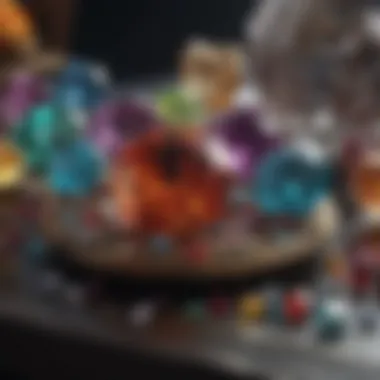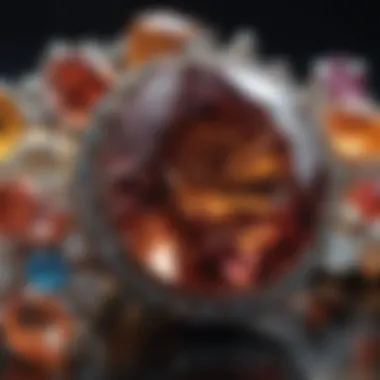The Beauty and Function of Table Jewels in Design


Intro
The world of gemstones has always beckoned both enthusiasts and the casual observer alike, revealing layers of beauty and meaning that often go beyond mere aesthetics. At the heart of this fascination lies the allure of table jewels—those stunning mineral marvels that can transform any space into a sanctuary of elegance. But what exactly are table jewels? They encompass a variety of gemstones, both polished and raw, used not just for their sparkle but also for their cultural significance and purported healing capabilities.
In this exploration, we will embark on a journey to uncover the rich history, craftsmanship, and the myriad roles that table jewels play in modern decor. This article showcases the exquisite nature of these gems, delving into why they remain relevant in both interior design and holistic practices. By bringing together enthusiasts, decorators, and healers, we aim to present a well-rounded view of these remarkable stones.
Gemstone Overview
Description of the Gemstone
Table jewels are more than mere decorations; they represent nature’s artistry, born from the Earth through geological processes that take eons to unfold. These stones vary in size, shape, and color, exhibiting a spectrum that ranges from the clarity of quartz to the deep hues of amethyst. Each gemstone bears its unique narrative, linked inexorably to the environment in which it formed. Take a moment to imagine the journey of an amethyst from the volcanic eruptions that formed it to the last touch of a craftsman polishing its surface.
Physical Properties
The physical attributes of gemstones fall into a few key categories that influence their desirability:
- Hardness: Measured on the Mohs scale, this determines a stone's durability. For instance, diamonds, with a score of 10, are the hardest, while talc rests at a soft 1.
- Color: This may vary based on impurities that affect how light interacts with the stone. A simple piece of quartz can appear clear, smoky, or even rose-colored depending on its formation.
- Luster: A term used to describe how light reflects off the surface. Gems may exhibit brilliance or dullness, each offering different visual experiences.
- Transparency: This ranges from transparent to opaque, dictating the gem's visual impact in an interior context.
These properties create a foundation for understanding not just how to display table jewels, but also how to appreciate their individual stories and potential.
"Every gemstone tells a story—its journey through time and the secrets it harbors inside."
Healing Properties
Metaphysical Attributes
For many enthusiasts, table jewels serve a dual purpose: they are both exquisite decor and sources of healing energy. Each gem is believed to resonate with specific energies, purportedly aiding various aspects of life. For example, lapis lazuli is thought to enhance communication, while rose quartz is often associated with love and emotional healing. Different cultures have revered these attributes, often seeing gemstones as conduits for universal energies.
Common Uses in Holistic Practices
In holistic practices, table jewels are employed in a variety of methods:
- Meditation: Many practitioners use stones like clear quartz to focus their intent during meditative practices, enhancing the experience.
- Crystal Layouts: Specific arrangements of gems are believed to create energy grids, said to facilitate harmony within a space.
- Jewelry Crafting: Wearing stones like citrine or amethyst is common for those wishing to carry their properties with them throughout the day.
The intersection of beauty and healing makes table jewels more than just decorative items; they become integral tools in enhancing one’s environment and well-being.
By weaving through the historical and practical dimensions of table jewels, we can appreciate them not only for their look but also for their deeper meanings and potential influence in everyday life.
Understanding Table Jewels
Table jewels serve a fascinating purpose beyond merely acting as decorative objects. They bridge the gap between nature's artistry and human creativity, revealing insights into not just their aesthetic appeal but also their functionality in everyday life. These small, often exquisite pieces, typically fashioned from gemstones and crystals, have established their importance in home decor and personal expression. Understanding table jewels means delving into their various types, historical significance, and the peace they can add to our living environments. This article's focus on table jewels equips readers with knowledge that can enhance their appreciation of these stunning accouterments in modern life.
Definition of Table Jewels
Table jewels can be defined as ornamental objects often made from natural or synthetic gemstones that adorn tables and other surfaces in homes or public spaces. Not limited to just aesthetically pleasing pieces, these jewels can also include items like coasters, decorative bowls, or even sculptures designed from precious materials. The essence of table jewels lies in their dual capability to beautify and serve a practical function. For a gemstone enthusiast, the allure often lies in the unique characteristics and qualities that each stone possesses.
Historical Context of Table Jewels


Historically, the concept of table jewels stretches far and wide across cultures and epochs, each era adding layers of meaning and technique. In ancient times, civilizations like the Egyptians and Romans embraced the beauty of gemstones, not only using them in jewelry but also incorporating them into elaborate decorative pieces for feasts and significant gatherings. For instance, the use of lapis lazuli in Persian dining tables illustrated prestige and wealth.
Over time, these creations merged with advancements in artistry, moving from simple carvings to intricate designs made with the utmost precision. As cultures transformed, so did the interpretations of what table jewels symbolize. In modern contexts, these jewels can be seen as reflections of personal identity and aesthetic taste.
Table jewels today have evolved significantly, blending traditional and contemporary craftsmanship. Their significance remains rooted in a historical legacy that manifests in every gleaming facet and alluring color tint.
"Table jewels are not just eye-candy; they're the whispers of history molded into a sparkling future."
By comprehending the historical context of these jewels, enthusiasts can truly appreciate their value beyond appearance, recognizing how they carry the weight of history and culture. This appreciation ultimately deepens the connection to the pieces that grace our homes, making them more than mere decorations.
Types of Table Jewels
Table jewels are not just decorative pieces; they also relate deeply to aspects such as personal expression and cultural heritage. Understanding the various types of table jewels enriches the experience of integrating them into one’s space, making the discerning reader more informed and appreciative. This section will dissect precious gemstones, semi-precious stones, and the dynamic between synthetic and natural table jewels. Each type carries its own characteristics and history that adds layers of meaning and value.
Precious Gemstones
Precious gemstones, often celebrated for their beauty and rarity, include diamonds, sapphires, rubies, and emeralds. The allure of these stones contributes heavily to their high market value, making them sought-after by collectors and enthusiasts alike.
The cutting process of a precious gemstone is meticulous and demands a blend of artistry and skill. Each cut highlights the stone's inherent qualities, improving its sparkle and overall appearance. For instance, a well-cut diamond can reflect light in such a way that it dazzles in any light source. Furthermore, their symbolic meaning often transcends simple aesthetics. Diamonds, for example, are associated with everlasting love, whereas sapphires symbolize wisdom and nobility.
Additionally, precious gemstones often come with fascinating stories related to their origins. Ruby, known as the
Crafting Table Jewels
Crafting table jewels is not just a mere hobby; it's an art form that resonates with history, culture, and the sublime beauty of nature. For anyone delving into this intricate realm, understanding the methods behind these stunning creations provides a deeper appreciation for them. The process of crafting table jewels involves specific techniques, design considerations, and a narrative steeped in tradition and innovation.
Techniques in Gemstone Cut and Polish
The gemstone cutting and polishing process is akin to sculpting. It can transform a rough stone into a dazzling piece that reflects light in captivating ways. A key aspect of this process lies in the choice of cut. Brilliant cut, for instance, emphasizes the stone’s clarity and brightness. Other styles, like the emerald cut, focus more on the stone's crystalline structure, showcasing its depth and inclusivity.
In the craft community, the choice of tools is crucial. Lapidary artisans often employ diamond-tipped blades and polishing wheels to refine each gem. It’s detailed work that requires a steady hand and a keen eye. At every stage, artisans meticulously inspect the gemstones under various lighting conditions to ensure quality. They might spend hours perfecting just one stone, demonstrating the patience and skill integral to the craft.
"A gem is not just a rock; it is a story held within a brilliant facade."
This commitment to quality doesn't just affect the beauty of the stone; it impacts its value upon reaching the market. Well-crafted gemstones, with precise cuts reflecting light flawlessly, tend to command higher prices among collectors and enthusiasts. Therefore, investing time in this stage is not just beneficial but essential for quality assurance and market competitiveness.
Design Considerations for Table Jewels
When it comes to the design of table jewels, various factors come into play. First and foremost is the relationship between the jewel and its intended space. A table centerpiece invites interaction—its style must harmonize with the surrounding decor. For example, a bold, vibrant amethyst can act as an eye-catching focal point in a minimalist room, while a collection of smaller jade stones may seamlessly blend into a vintage setup.
There are also practical aspects to consider. The weight of the table jewels plays a crucial role. Heavier stones may need a more stable base, while lighter ones can be navigated with ease. Another aspect is color theory—designers often lean on complementary colors to create a dynamic visual experience.
Factors such as shine, texture, and size also hold significance. A smooth, polished surface may radiate elegance, while a rough texture could evoke a rustic charm. Each design choice communicates a narrative, reflecting the tastes of both the creator and the user. This thoughtful approach ultimately shapes how these table jewels contribute to the overall ambiance of a space.
The Aesthetic Appeal
The allure of table jewels goes beyond mere beauty; it lies in their ability to elevate spaces, enhance moods, and even tell stories. When considering the aesthetic appeal of these stunning stones, it is essential to understand how they can gracefully intertwine with our interior spaces. They are not simply decorative objects but rather integral elements that can transform everyday environments into havens of elegance and tranquility.


Positioning Table Jewels in Interior Spaces
Positioning table jewels effectively within an interior space requires a discerning eye and an understanding of the surrounding design. These gemstones can be placed strategically to draw attention and create focal points. For instance, a well-placed amethyst geode can serve as a captivating centerpiece on a dining table, while smaller, polished quartz crystal clusters can enhance the ambiance on a bookshelf or side table.
Moreover, consider the harmony between color, light, and the table jewels. Natural light can illuminate the facets of a cut stone, rendering it a living artwork.
- Choose your spot wisely: Consider high-traffic areas where they can catch the light during the day.
- Grouping: Items of similar hues can create a cohesive look, while contrasting colors can add dynamism.
- Layering: Alternate heights and sizes to craft a visually engaging layout.
By thoughtfully incorporating table jewels into your home, you're not just decorating but inviting conversations, stimulating creativity, and inspiring personal reflection. These elements become conversation starters, often evoking stories about their origins, crafting, or unique characteristics.
Color and Texture Impacts
The impact of color and texture in table jewels is profound. Each gemstone has its own unique spectrum of hues and textures that can influence the mood of a space. For example, warm tones like yellow citrine or red garnet can infuse a room with warmth and energy. In contrast, cool tones from blue lapis lazuli or green jade can evoke calm and serenity.
Textures should also be taken into account. A rough unpolished stone can add a rustic charm, while a flawlessly polished surface radiates luxury. Here are a few considerations:
- Vibrancy: Bright gems can invigorate or energize a dull corner.
- Layering Texture: Mixing smooth and rough textures brings complexity.
- Seasonal Changes: Different stones can be used throughout the seasons to reflect nature's transitions, like deep amber in fall or clear quartz in winter.
The fusion of color and texture can turn any space into an experiential journey where sight and feel play equally important roles.
In summary, recognizing the aesthetic appeal of table jewels not only enhances the beauty of spaces but also influences our emotional and psychological experiences within them. Select stones that speak to you and remember that their placement and the colors involved can change the entire atmosphere of a room, turning it from ordinary to extraordinary.
Metaphysical Properties of Table Jewels
Table jewels, often perceived merely as captivating decor, hold profound significance in the metaphysical realm. This section examines how these beautiful gemstones resonate with spiritual energy, potentially influencing our emotional, physical, and mental well-being. It is important to recognize that the allure of these jewels transcends aesthetics; they are considered powerful tools for healing and energetic enhancement in personal spaces.
Healing Properties of Specific Gemstones
Different types of gemstones are thought to carry unique healing properties, making them more than just shimmering adornments on a table. Each stone holds specific vibrational frequencies that enthusiasts believe can interact with the human energy field.
- Amethyst: Often dubbed the stone of peace, amethyst is thought to soothe the mind and alleviate stress. It's said to be helpful in reducing anxiety and promoting restful sleep.
- Rose Quartz: Known as the stone of love, rose quartz is believed to foster love and emotional healing. It’s often used to create an atmosphere of tenderness and compassion.
- Clear Quartz: This versatile crystal is regarded as a master healer. Practitioners claim it can amplify energy and intention, making it an invaluable ally for many.
- Citrine: Renowned for its sunny disposition, citrine is associated with abundance and prosperity. Many people use it to manifest wealth and financial security.
These stones can be strategically placed in living environments to leverage their healing attributes, offering support in everyday emotional challenges.
Energetic Influences in Spaces
The placement of table jewels within a space can drastically alter its energy flow. It is believed that these gemstones not only enhance physical surroundings but also influence the emotional atmosphere.
- Chakra Alignment: Many practitioners align gemstones with the body’s chakras, or energy centers. For instance, placing a green emerald at heart level is thought to promote healing in that region of the body.
- Feng Shui: Adopting principles from feng shui, specific gems like black tourmaline can be positioned near entryways to repel negative energy, while clear quartz can be used in living spaces to promote clarity and calmness.
- Intentional Setting: Creating spaces with intention is also significant. The act of dedicating a specific area for meditation adorned with particular gemstones can enhance one's spiritual practice, inviting a deeper connection with one’s inner self.
In summary, the metaphysical properties of table jewels are rich and diverse, promising to add a layer of depth to one's living environment. By understanding their healing properties and the energetic influence they can exert, enthusiasts can better appreciate their role within both interior design and personal wellness.
Cultural Significance of Table Jewels
Cultural significance of table jewels transcends mere aesthetics; it weaves itself into the fabic of our traditions, ceremonies, and even daily lives. Each gemstone carries its own story—stories that vary from one culture to another, shaped by local beliefs, history, and customs. Understanding these cultural contexts not only deepens our appreciation for these stunning creations but also enhances our connection to the past and present.
Historical Use Across Cultures


From ancient Egypt, where turquoise adorned the tombs of pharaohs, to the vibrant markets of India, where rubies and emeralds are deemed symbols of prosperity, table jewels have played a significant role throughout history. In Egypt, turquoise was not only appreciated for its color but was also believed to hold spiritual protection for the dead. The ancient Egyptians considered it a bridge between earthly and divine realms.
Meanwhile, in India, the use of gemstones dates back over 5,000 years. They were not just decorative objects but were believed to possess healing properties. For example, sapphires are linked to wisdom and royalty, while diamonds symbolize purity and strength.
Across the world in the Middle Ages, lapidaries crafted intricate pieces that served both as weaponry for protection and as artistic expressions of faith, with gemstones often embedded in religious artifacts. This integration of beauty and utility remains a hallmark of cultural uses of table jewels, underscoring their dual nature.
Contemporary Cultural Interpretations
In today's world, table jewels continue to attract interest not just as collectibles but also as symbols of status and personal narratives. They often find their way into contemporary art, fashion, and design, appealing to a sense of personal identity and expression.
For example, many modern interior designers now use table jewels wittingly, integrating them into spaces to enhance ambiance and reflect the personality of the inhabitant. The current trend of mixed materials in design allows gemstones to take center stage, often featured on tables or as statement pieces. This shift highlights a growing recognition of their cultural significance in contemporary lifestyles.
Additionally, contemporary practices have embraced the era of digital storytelling, where online platforms allow individuals to share their connections to specific stones. What was once a private transaction is now a sharable experience among gemstone enthusiasts and collectors. Many individuals post their unique finds on social media, turning their ownership into a cultural phenomenon.
"Every stone has a story; it carries the weight of culture, traditions, and sometimes, the whispers of our ancestors."
In summary, understanding the cultural significance of table jewels enriches the way we view and engage with these captivating pieces. It reminds us that they are more than mere objects of beauty; they are vessels of history, culture, and personal significance.
Maintenance and Care for Table Jewels
The capture of beauty within table jewels is not just in their luster and design but also in how they are maintained. Proper maintenance assures that the gemstones continue to radiate their charm over time. Like any prized possession, these jewels require care to preserve their brilliance and structures. Ignoring their upkeep diminishes their beauty and can potentially lead to irreversible damage. Thus, understanding the significance of proper maintenance becomes necessary for any gemstone enthusiast or collector.
Cleaning Techniques for Different Gemstones
The cleaning of gemstones varies significantly based on their material properties, and employing the right technique is crucial. Here are some guidelines for popular types:
- Diamonds: Diamonds fare well with warm, soapy water. Use a soft brush to remove dirt and grime, ensuring not to scratch their surface. Rinse them under running water and dry using a lint-free cloth.
- Emeralds: Being relatively soft, emeralds should never be soaked. A damp, soft cloth suffices to clean their surfaces. It's important to avoid harsh cleaners since they may damage the oil treatment many emeralds receive.
- Opals: Opals absorb water, making prolonged exposure risky. Clean them gently with a damp cloth and dry immediately. Never immerse them in water.
- Rubies and Sapphires: These can handle warm soapy water as well. A soft brush will help reach crevices. Just be careful with any settings that may catch the brush.
In summary,
Using one-size-fits-all cleaning methods can harm your stunning table jewels; tailor your approach based on individual gemstone properties.
Storage Recommendations
Proper storage of table jewels is another critical aspect of maintenance. Storing them well can prevent scratches, chips, or even tarnishing. Here are some tips:
- Individual Storage: Always store each gemstone separately. Use soft pouches or dividers in a jewelry box to prevent friction between different pieces.
- Avoid Humidity: Keep your table jewels in a cool, dry place. Humidity can negatively impact stone integrity, especially for softer gemstones like opals and emeralds.
- Use Anti-Tarnish Strips: For any metallic components, consider placing anti-tarnish strips in your jewelry box. They can help slow down the tarnishing process on settings, ensuring their longevity.
- Regular Checks: At intervals, inspect your gemstones for any signs of wear or loosening in settings. Catching these issues early can save significant trouble later.
To sum it up, the joy of owning table jewels comes not just from their beauty but also in how one tends to them. Regular cleaning and thoughtful storage will help preserve their allure, ensuring these precious pieces remain as enchanting as the day you first laid eyes on them.
Closure
As we draw this exploration of table jewels to a close, it’s crucial to recognize the multifaceted importance of these distinct gems. Rather than just being decorative pieces, table jewels serve a deeper purpose that intertwines aesthetic appeal with cultural significance and metaphysical properties. In both historical and modern contexts, their allure can not be understated.
Recap of Key Points
To summarize the key points discussed in this article:
- Understanding Table Jewels: We defined table jewels and explored their historical context, illustrating how their significance has evolved over time.
- Types of Table Jewels: Various classifications such as precious gemstones and semi-precious stones were outlined alongside the distinctions between synthetic and natural creations, which play a pivotal role in market preferences.
- Crafting Techniques: The article highlighted different techniques in cutting and polishing, stressing the skill and artistry involved in their creation.
- Aesthetic Appeal: We examined how proper positioning and the interplay of color and texture can dramatically enhance interior spaces.
- Metaphysical Properties: Not only do these gems serve ornamental functions, but they also carry attributes believed to promote healing and wellness.
- Cultural Significance: Table jewels have woven their way through various cultural narratives, from ritual uses to contemporary interpretations.
- Maintenance and Care: We underscored the importance of proper care and storage to ensure these pieces retain their luster through generations.
Future Trends in Table Jewels
Looking ahead, several trends appear poised to shape the future of table jewels:
- Sustainability: There's an increasing demand for ethically sourced gems. Consumers are becoming more aware of the environmental and social implications of gemstone mining. Expect to see more brands commit to sustainable practices.
- Technology in Craftsmanship: Innovations like laser-cutting and 3D printing may gain traction, allowing for intricate designs that were previously unachievable through traditional methods.
- Education and Awareness: As society grows more curious about the origins and meanings of these stones, we might see a rise in educational initiatives — from workshops to online classes focused on understanding the unique traits and metaphysical properties of various table jewels.
- Customization: More enthusiasts are seeking personalized pieces, tailored specifically to their aesthetic desires as well as metaphysical needs.







